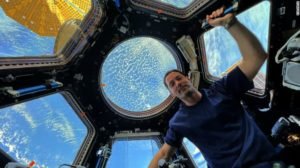Double asteroid redirect test spacecraft (DART) gives NASA just uploaded the first image of its target, the moon Dimorphos, as well as its orbital body, the asteroid Didymos.
DART is a planetary defense test mission designed to impact the Moon to change its trajectory around Didymos. If this spacecraft design proves effective, it could be scaled up to deflect asteroid connected to Earth (Didymus and Dimorphos pose no threat to Earth—they are a testing ground for kinetic impact technology.)
Read more:
The image, which consists of 243 individual images, was obtained using a single DART instrument, the Didymos Reconnaissance and Asteroid Camera for Optical Navigation (DRACO); was taken on 27 July and released on Wednesday (7th).
In the photograph, Dimorphos and Didymos are depicted as a single luminous point – at this moment the spacecraft was still 32 million kilometers from the asteroids, so they seem indistinguishable.

“This first set of images is being used as a testbed to test our imaging techniques,” said DART mission systems engineer Elena Adams of the Johns Hopkins University Applied Physics Laboratory in Maryland, USA, who is leading the mission.
“The image quality is similar to what we could get from ground-based telescopes, but it is important to show that DRACO is working correctly and can see its target in order to make the necessary adjustments before we start using the images to control the spacecraft. the asteroid is properly autonomous,” Adams said.
DART will use DRACO to navigate to the crash site completely independent of its ground controllers.
Over the next three weeks, the team will use footage captured every five hours to perform a series of three trajectory correction maneuvers that will steer the DART on a precise path to Didymos. Then, approximately 24 hours after impact, DART will begin fine-tuning its final approach.
“By seeing images of Didymos for the first time, we can tweak the best settings for DRACO and tweak the software,” Julie Bellerose, head of DART navigation at NASA’s Jet Propulsion Laboratory in California, said in the same statement.
“In September, we will refine the DART target with a more accurate location of Didymos.” Since these pictures were taken, DRACO has checked Didymos three more times.
with information from space


